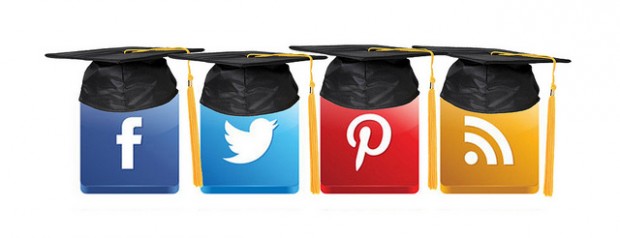This week’s topic of Social Media and Learning was especially interesting for me because of the two key points in the module:
- The educational system acts to “isolate students within the walls of an educational model” is based on pre-industrial revolution world, despite the fact that knowledge accessibility and notions of authority have and are continuing to change.
- “Trying to build stronger walls to keep the digital world and its information flows out is not going to work”.
Social media is a part of today’s world, and in order to educate individuals for today’s world Social Media must be integrated into teaching and learning practices. Bryan Alexander, describes a number of ways, from social book-marking, collaborative writing, to RSS feeds, blogging, and wiki projects. that social media is being used in education (2006). The article How Twitter can be Used as a Powerful Educational Tool, explores how Twitter can be used in education (2012). There is no shortage of the (Web 2.0) numerous apps, and social media tools that educators are able to, sometimes quite creatively, apply to their learning outcomes.
In this chapter, Bates (2014) poses the question about what new learning outcomes could the use of social media help develop? There are a number of outcomes which require special attention when it comes to the use of social media:
- Digital literacy – Students need to know how to access, create using information communication technologies (ITCs) and the Internet.
- Critical thinking – Students need to be able to critically assess the merits of online media. They need to be able to quickly “filter” through large amounts of information to determine what is most valuable to them.
- Content creators – As content creators, and re-mixers students need to be aware of copyright practices, digital tattoos, and any privacy concerns.
Bates also asks whether it would it be better just to add social media to the course or to re-design it around social media (2014)? This question is not so straightforward, as the nature of the learning content factors into how social media can be incorporated as well as practical considerations. Considerations such as the lack of high bandwidth internet connections, and lack of digital literacy in the incorporation of social media in course design. For example, it’s not reasonable to assign a video creation project for an online course, and then assess students in remote regions on the same criteria as students with more computer knowledge, experience and faster internet access.
As far as whether the course should incorporate social as an enhancement to the teaching, or whether the course should be designed around the use of Social Media really depends on the content and the course objects. In How Twitter can be Used as a Powerful Educational Tool, the geometry teacher was able use Twitter to engage students. The Khan Academy online videos can be used to better learn geometry. But these inclusions can replace traditional modes for teaching, where for example an instructor poses a question, or gives a lecture. A more extensive use of social media may work better for teaching a Communications or Political Science (Alexander, 2006) where much of the course assignments or learning can be in an online/social media environment where students can collaborate, share and re-mix existing information and media with more ease.
Works Cited
- Alexander, B. (2006). Web 2.0: A new wave of innovation for teaching and learning? EDUCAUSE Review, 41(2), 34-44. Retrieved from http://www.educause.edu/ir/library/pdf/ERM0621.pdf
- Bates, T. (2014). Pedagogical differences between media: Social media. In Teaching in digital age. Retrieved from http://opentextbc.ca/teachinginadigitalage/chapter/9-5-5-social-media/ (Chapter 7, point 6)
- November, A. (2012). How Twitter can be used as a powerful educational tool. November Learning [Weblog] Retrieved from http://novemberlearning.com/educational-resources-for-educators/teaching-and-learning-articles/how-twitter-can-be-used-as-a-powerful-educational-tool/

Hi Parmdip,
I agree that the content should determine whether social media is an enhancement or the basis of course design, and I like your idea of using social media as means for students to re-mix and collaborate around media and information outside of the classroom context. I wonder though if connecting with students through social media creates a sense of constant connection, and how this might play out in terms of teacher access or availability to students. It’s something that I’ve been considering this week, as the teacher work/life balance is currently a hot topic of conversation at our school.
– Allen.
Great points Parmdip. The walls of the classroom are there to create a space for learning, not limit the learning taking place. Embracing the flexibility social media allows with the guidance of the environment within the physical structure, can be truly powerful. If students can use outside sources in a fraction of the time to support well thought out learning objectives and tasks designed by experts in learning, then we have succeeded. Even those resistant to the idea of social media are quickly finding themselves unable to stop it. Many of our students use these types of technologies for non-academic purposes. Leveraging their knowledge of the technology into school based learning opportunities makes a connection between the world outside the classroom and the ‘foreign’ world within.